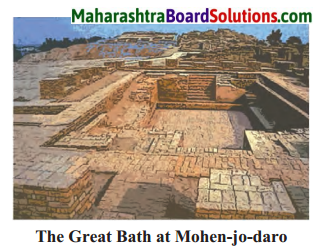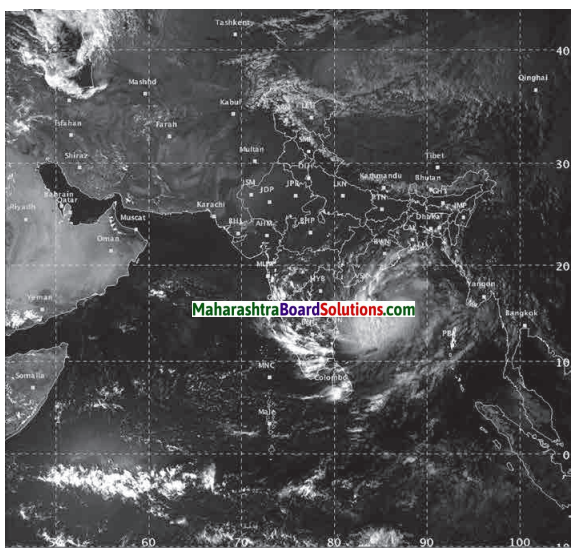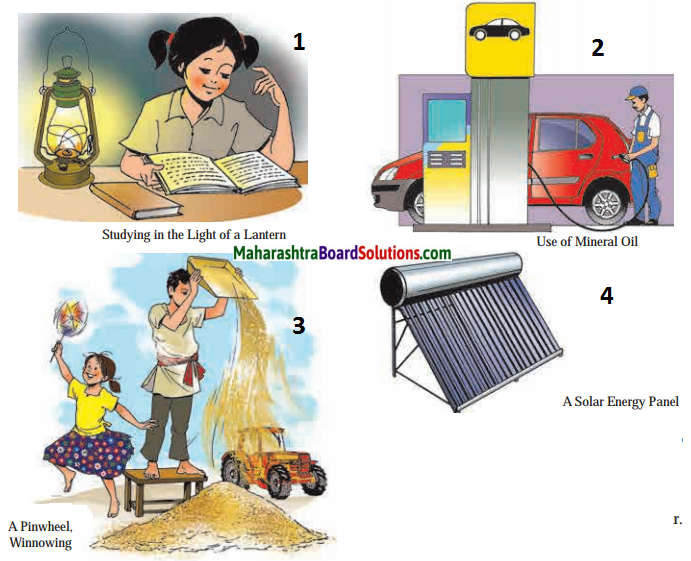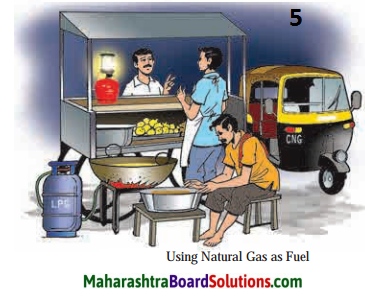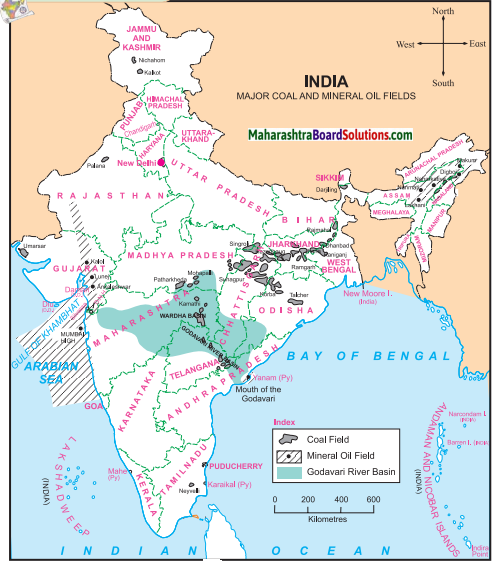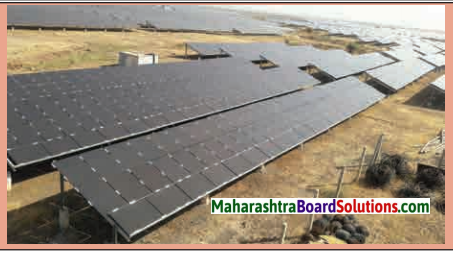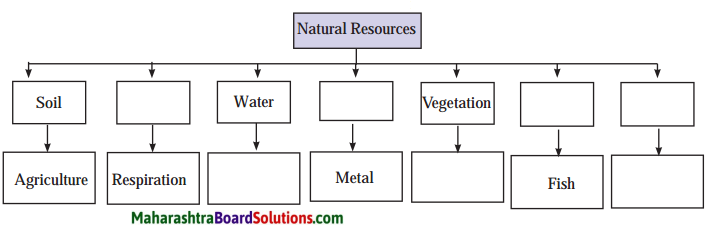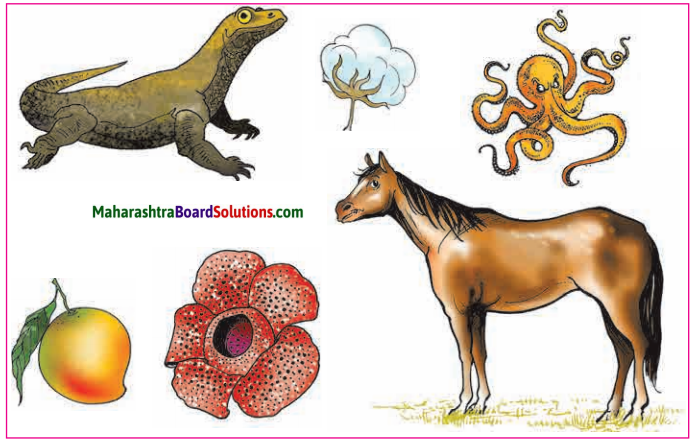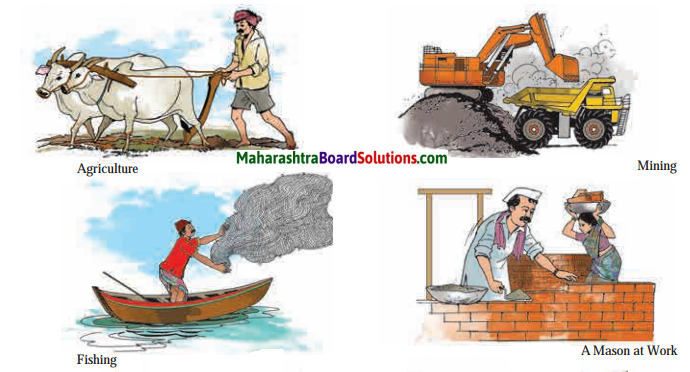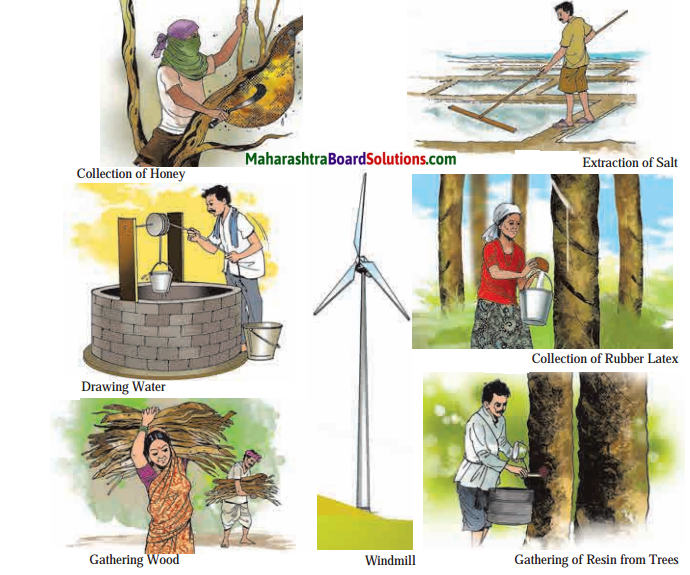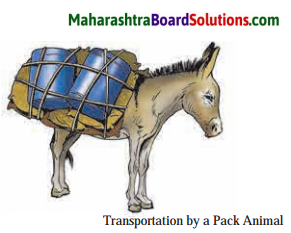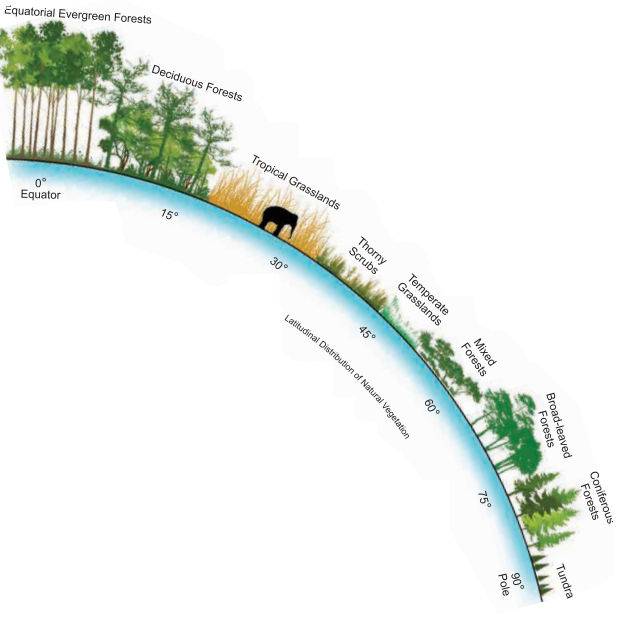Balbharti Maharashtra State Board Class 6 Geography Solutions Chapter 7 Rocks and Rock Types Notes, Textbook Exercise Important Questions and Answers.
Maharashtra Board Class 6 Geography Solutions Chapter 7 Rocks and Rock Types
Class 6 Geography Chapter 7 Rocks and Rock Types Textbook Questions and Answers
B. Which of the following monuments are built in igneous rock?
(1) The Taj Mahal
(2) Fort Raigad
(3) The Red Fort
(4) Ellora Sculpture
Answer:
Ellora Sculpture

C. Find the differences between:
Question 1.
Igneous and sedimentary rocks
Answer:
| Igneous rocks |
Sedimentary rocks |
| (i) Igneous rocks are rocks formed by cooling and solidifying of molten materials.
(ii) Igneous rocks are hard and homogeneous.
(iii) Examples: Basalt, pumice |
(i) Rocks that are formed through deposition and compaction of sediments, especially rock particles transported by rivers, glaciers, wind, etc., are called sedimentary rocks.
(ii) Sedimentary rocks are generally brittle and light weight.
(iii) Examples: Sandstone, limestone, shale, corals |
Question 2.
Sedimentary and metamorphic rocks
Answer:
| Sedimentary rocks |
Metamorphic rocks |
| (i) Rocks that are formed through deposition and compaction of sediments, especially rock particles transported by rivers, glaciers, wind, etc., are called sedimentary rocks. |
(i) Rocks are formed due to the process of metamorphosis are called metamorphic rocks. |
| (ii) One may find fossils in sedimentary rocks.
(iii) Sedimentary rocks are brittle and light weight. Examples: Shale, corals |
(ii) Metamorphic rocks do not contain fossils.
(iii) Metamorphic rocks are heavy and hard. Examples: Marble, slate |
Question 3.
Igneous and metamorphic rocks
Answer:
| igneous rocks |
Metamorphic rocks |
(i) Igneous rocks are rocks formed by cooling and solidifying of molten material.
(ii) Igneous rocks are hard and homogeneous.
(iii) Examples: Basalt, pumice |
(i) Rocks formed due to the process of metamorphosis are called metamorphic rocks.
(ii) Metamorphic rocks are heavy and hard.
(iii) Examples: Gneiss, slate |
D. Which types of rocks are predominantly found at the following locations?
(1) Central Maharashtra
(2) South Konkan
(3) Vidarbha
Answer:
| Locations |
Types of rocks |
| (1) Central Maharashtra |
(a) Basalt |
| (2) South Konkan |
(b) Laterite and granite |
| (3) Vidharbha |
(c) Basalt, granite and sedimentary rocks |
Activity:
Collect rock specimens from your surroundings and also during your travels. Classify them with the help of your teacher. Make a small museum of rocks for your school and place your specimens there. Keep a note of the place from where you have collected them. (See a specimen
display on page 65.)
Visit the historical sites in your surroundings, e.g., hill forts, masonry dams, land forts, bastions, wadas, temples, mosques, etc. and observe with the help of your teacher, the rock used for their construction.

Class 6 Geography Chapter 7 Rocks and Rock Types InText Questions and Answers
Do it yourself!
From the hills, river-beds or the land in your vicinity, collect rock specimens of different types, shapes, colours, etc. Observe the rock specimens and note down the following.
Question 1.
Place where the rock was found:
Answer:
Sahyadri mountain (Basalt)
Question 2.
Colours of the rock:
Answer:
Dark-black colour.
Question 3.
Spots on the rock and their colour:
Answer:
Dark grey to black.
Question 4.
Weight of the rock (estimated, heavy/light):
Answer:
Heavy.
Question 5.
Hardness of the rock, (hard/ brittle/medium):
Answer:
Hard.
Question 6.
Structure of the rock, (uniform grains/layers/ hollowness):
Answer:
Uniform grains.
Question 7.
Porosity of the rock, (porous/non-porous):
Answer:
Non-porous.

Observe the pictures given below and answer the questions:

Question 1.
What is the hill in ‘A’ made up of?
Answer:
Hill in ‘A’ is made up of soils and rocks.
Question 2.
What is being done in B’?
Answer:
In ’B’, the process of digging is shown. The land is dug and the rocks and soil that is extracted is loaded in to a truck.
Question 3.
What do we see in ‘C’?
Answer:
In ‘C’ we see pebbles and rocks of different types, shapes, colours, etc.
Question 4.
Is there any relationship between the three things shown above?
Answer:
Yes, these are all pictures of naturally occurring processes on land leading to rock and soil formation.
Question 5.
For what purpose do we use the things shown in A and C?
Answer:
We use things shown in A and C for construction purposes; coloured pebbles are used for decoration.
Use your brain power!
Question 1.
What rock was used for building the forts in Maharashtra? Why?
Answer:
Igneous rocks were used for building the forts in Maharashtra as they are hard, homogeneous and heavy.
Question 2.
Find the meaning of this line from a famous Marathi poem:
राकट देशा, कणखर देशा. दगडांच्या देशा
Answer:
The poet through this line conveys the message that our land is made up of hard rocks. We are a powerful entity and nothing can pose a threat to our Motherland. We can understand all odds.
Similarly like our terrains which are strong, the people of our country are also strong and invincible, incapable of being conquered.
We have imbibed the value of resilience and courage and the ability to withstand all challenges from our terrain.

What will you do?
Ajit is interested in sculpting. He wants to prepare a sculpture of Dr. APJ Abdul Kalam.
He cannot decide which rock he should use for this, igneous, sedimentary or metamorphic? What will be your advice?
Answer:
I would advise him to use a metamorphic rock like marble. Due to the translucent nature of the marble, it will give the sculpture a glow. Properties like softness and easy availability makes the metamorphic rock, marble an ideal choice. These rocks are heavy and hard. Hence, they are ideal for making sculptures.
Class 6 Geography Chapter 7 Rocks and Rock Types Additional Important Questions and Answers
Fill in the blanks choosing the correct options from the bracket:
Question 1.
Rocks are a mixture of different minerals formed by natural processes in the _____. (lithosphere, atmosphere, hydrosphere)
Answer:
lithosphere
Question 2.
There are ______ types of rocks according to their formation process. (four, three, five)
Answer:
three
Question 3.
When the molten material, known as magma within the crust and lava on the surface, cools down, it solidifies giving rise to ____ rocks. (Sedimentary, Igneous, Metamorphic)
Answer:
Igneous
Question 4.
We get fossils in ______ rocks. (Sedimentary, Igneous, Metamorphic)
Answer:
Sedimentary
Question 5.
The Maharashtra plateau and the Sahyadris are formed out of _______ rocks. (Sedimentary, Igneous, Metamorphic)
Answer:
Igneous
Question 6.
______ is a major example of igneous rocks. (Shale, Basalt, Corals)
Answer:
Basalt

Question 7.
Water percolating through rocks dissolves the soluble minerals leading to ________ of rocks, (weathering, compaction, increased porosity)
Answer:
weathering
Question 8.
_______ is a sedimentary rock. (Basalt, Sandstone, Pumice)
Answer:
Sandstone
Question 9.
The study of _______ provide information about life in that period. (metamorphosedrocks, Igneous rocks, fossils)
Answer:
fossils
Question 10.
_______ gets metamorphosed when it undergoes heavy pressure, and intense heat. (Coal,,Peat, Silica)
Answer:
Coal
Question 11.
_______ rock is found in the eastern parts and in South Konkap. (Granite,.Marble,Pumice)
Answer:
Granite
Question 12.
________ activity is concentrated in South Konkan and eastern Maharashtra. (Fishing, Mining, Construction)
Answer:
Mining
Question 13.
_____ is referred to as primary rocks. (Igneous rock, Sedimentary rock, Metamorphic rocks)
Answer:
Igneous rock
Question 14.
________ is a major example of igneous rock. (Basalt, Pumice, Sedimentary)
Answer:
Basalt

Question 15.
______ rocks are ‘formed due to compaction of material. (Metamorphic, Sedimentary, Igneous)
Answer:
Sedimentary
Question 16.
_________ rocks are heavy and hard. (Sedimentary, Metamorphic, Igneous)
Answer:
Metamorphic
Question 17.
When coal gets metamorphosed into ______ , its price increases. (garnet, diamond, opal)
Answer:
diamond
Question 18.
______ is found in South Konkan Maharashtra. (Granite, Laterite, Basalt)
Answer:
Laterite
Match the pairs correctly:
Question 1.
| Column A |
Column B |
| (1) Igneous rocks |
(a) brittle and light weight |
| (2) Sedimentary rocks |
(b) heavy and hard |
| (3) Metamorphic rocks |
(c) hard and homogeneous |
Answer:
1 – c
2 – a
3 – b
Complete the tabular form:
| Original Rock |
Metamorphosed Rock |
| Granite |
_________ |
| Basalt |
__________ |
| _________ |
Marble |
| Coal |
___________ |
| Sand Stone |
__________ |
| _________ |
Slate |
Answer:
| Original Rock |
Metamorphosed Rock |
| Granite |
Gneiss |
| Basalt |
Amphibolite |
| Limestone |
Marble |
| Coal |
Diamond |
| Sand Stone |
Quartizte |
| Shale |
Slate |

Name the following:
Question 1.
Two major rock-forming minerals:
Answer:
Silica, aluminium.
Question 2.
Hard and homogeneous rocks:
Answer:
Igneous rocks.
Question 3.
Two sedimentary rocks:
Answer:
Shale, corals.
Question 4.
Rocks which does not contain fossils:
Answer:
Metamorphic and Igneous rock
Question 5.
One use of diamonds:
Answer:
Ornament making.
Question 6.
One activity which leads to increased pressure and heat in that region:
Answer:
Volcanic eruption.
Question 7.
Rock found in South Konkan:
Answer:
Laterite.
Question 8.
Rocks that formed by metamorphosis:
Answer:
Metamorphic rocks.
Question 9.
Two metamorphosised rocks:
Answer:
Marble, Slate.
Question 10.
Two igneous rocks:
Answer:
Granite and Basalt.
State whether the following statements are true or false:
Question 1.
The properties of rocks depend on their constituent minerals and their proportion alone.
Answer:
False.

Question 2.
Silica is a rock forming mineral.
Answer:
True
Question 3.
One may find fossils in Igneous rocks.
Answer:
False
Question 4.
Weathering of rocks leads to its disintegration or decomposition.
Answer:
True
Question 5.
Sedimentary rocks are hard and homogeneous.
Answer:
False
Question 6.
Maharashtra has large reserves of mineral wealth.
Answer:
False
Question 7.
The Maharashtra plateau and the Sahyadris are formed out of igneous rocks.
Answer:
True
Question 8.
Most of the hill forts in Maharashtra do not have lakes or elephant yards.
Answer:
False
Question 9.
One can easily see layers in the sedimentary rocks.
Answer:
True
Question 10.
Sedimentary rocks are generally heavy weight.
Answer:
False
Question 11.
Metamorphic rocks do not contain fossils.
Answer:
True
Question 12.
Metamorphic rocks are brittle and lightweight.
Answer:
false

Answer the following questions in short:
Question 1.
What are rocks?
Answer:
Rocks are a mixture of different minerals formed by natural processes in the lithosphere. Rocks are found on land surface and also below it.
Question 2.
What do the properties of rocks depend on?
Answer:
The properties of rocks depend on the constituent minerals and their proportion as well as on the formation process. Silica, aluminium, magnesium and iron are the major rock-forming minerals.
Question 3.
What are the three types of rocks?
Answer:
Igneous rocks, Sedimentary rocks and Metamorphic rocks are the three types of rocks.
Question 4.
What are Igneous Rocks?
Answer:
When the molten material, known as magma within the crust and lava on the surface cools down, it solidifies giving rise to igneous rocks.
Question 5.
What information does the study of fossils provide?
Answer:
Study of fossils provide information about the life in the olden period.
Question 6.
Write any two characteristics of metamorphic rocks.
Answer:
Metamorphic rocks are heavy and hard.
Question 7.
When does coal get metamorphosed?
Answer:
When coal undergoes heavy pressure and intense heat it gets metamorphosed.
Question 8.
When does the price of coal increase?
Answer:
The price of coal increases when it gets metamorphosed into diamonds.

Question 9.
What is referred to as primary rocks?
Answer:
Rocks are formed out of the material from the interior of the earth, these are referred to as primary rocks.
Question 10.
What is called fossils?
Answer:
The buried remains of dead animals or plants embedded in the rocks and preserved petrified form are called fossils.
Give geographical reasons for the following statements:
Question 1.
Igneous rocks are also referred to as primary rocks.
Answer:
As Igneous rocks are formed out of the material from the interior of the earth, these rocks are also referred to as primary rocks.
Question 2.
Most of the hill forts in Maharashtra have lakes or elephant yards.
Answer:
(i) Hillforts in Maharashtra are old quarry sites from which stone or other materials have been extracted for the construction of the fort and other buildings.
(ii) In the pits and dugouts left behind after rock extraction, water was allowed to accumulate and these lakes, banks, etc., were created.
(iii) Therefore, most of the hill forts in Maharashtra have lakes or elephant yards.
Question 3.
Weathering of rocks occurs.
Answer:
- Due to continuous variations in temperature, rocks develop cracks.
- Similarly, the water percolating through rocks dissolves the soluble minerals.
- This leads to the weathering of rocks.

Question 4.
One may find fossils in sedimentary rocks.
Answer:
- One can easily see layers in sedimentary rocks.
- While layers are getting deposited, the remains of the dead animals or plants get buried in these layers at times.
- Therefore, one may find fossils in sedimentary rocks.
Question 5.
Changes in nature, as well as the chemical composition of the original rocks, is witnessed.
Answer:
- Volcanic activity and other earth movements constantly take place on the earth.
- While these are occurring, the igneous and sedimentary rocks in that region are subjected to tremendous pressure and heat.
- This leads to changes in nature as well as the chemical composition of the original rocks.
Question 6.
Maharashtra does not have a large reserve of mineral wealth.
Answer:
Maharashtra does not have a large reserve of mineral wealth due to the thick and extensive layers of basalt rocks.
Answer the following questions in detail:
Question 1.
What leads to the development of sedimentary rocks?
Answer:
- Due to continuous variations in the temperature, rocks develop cracks.
- Similarly, the water percolating through rocks dissolves the soluble minerals leading to the weathering of rocks.
- They get disintegrated or decomposed i.e. reduced to pieces.
- These rock particles get transported by rivers, glaciers, wind, etc. towards low lying area and are deposited there.
- One after the other, layers of sediments gets deposited in this way.
- The upper layers exert heavy pressure on the lower layers.
- This leads to compaction of materials and development of sedimentary rocks.
Question 2.
How are Metamorphic rocks formed?
Answer:
- Volcanic activity and other earth movements | constantly take place on the earth.
- While these are occurring, the igneous or sedimentary rocks in that region are subjected to tremendous pressure and heat.
- This leads to changes in the nature as well as the chemical composition of original rocks.
- The crystals in the original rock gets recrystalized, the rock gets metamorphosed.
- The rocks formed through such a process are ! called Metamorphic rocks.

Question 3.
How is sand that flows in a river formed? Collect some information about where the sand comes from.
Answer:
- Moving streams are so powerful that it can wear away soil rocks.
- Rocks on higher land get eroded due to the strong current of the streams and they in turn get carried away into the sea.
- Silt too is brought down from the mountain top from where the streams originate.
- Most of the sand in the river is silt carried by the streams and the weather material from inland rocks transported by the streams.
- The moving of soil and rock with the stream, termed as erosion can be summed up as the cause of sand formation in a river.
![]()
![]()
![]()
![]()
![]()
![]()
![]()
![]()
